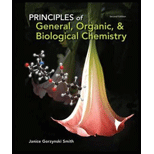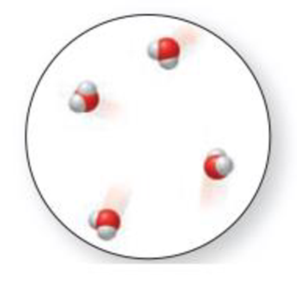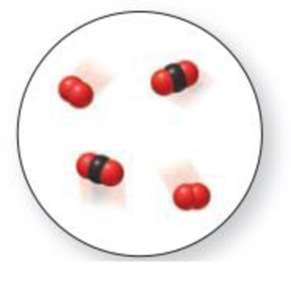
Principles of General Organic & Biological Chemistry
2nd Edition
ISBN: 9780077633721
Author: Janice Smith
Publisher: Mcgraw-hill Higher Education (us)
expand_more
expand_more
format_list_bulleted
Concept explainers
Textbook Question
Chapter 1.3, Problem 1.4P
Classify each example of molecular art as a pure substance or a mixture:


Expert Solution & Answer
Want to see the full answer?
Check out a sample textbook solution
Students have asked these similar questions
State two variables on which the transport number in electrochemistry depends.
Among the methods for measuring transport numbers are the Hittorf method and the moving surface method. Let's explain them briefly.
can you help me solve and highlight these hw
Chapter 1 Solutions
Principles of General Organic & Biological Chemistry
Ch. 1.1 - Imagine that your job as a healthcare professional...Ch. 1.2 - Characterize each process as a physical change or...Ch. 1.2 - Does the molecular art represent a chemical change...Ch. 1.3 - Classify each example of molecular art as a pure...Ch. 1.3 - Prob. 1.5PCh. 1.3 - Classify each item as an element or a compound:...Ch. 1.4 - Prob. 1.7PCh. 1.4 - If a nanometer is one billionth of a meter (0.000...Ch. 1.4 - Prob. 1.9PCh. 1.4 - Prob. 1.10P
Ch. 1.5 - How many significant figures does each number...Ch. 1.5 - Indicate whether each zero in the following...Ch. 1.5 - Prob. 1.13PCh. 1.5 - Carry out each calculation and give the answer...Ch. 1.5 - Prob. 1.15PCh. 1.6 - Prob. 1.16PCh. 1.6 - Prob. 1.17PCh. 1.6 - Prob. 1.18PCh. 1.7 - Prob. 1.19PCh. 1.7 - Prob. 1.20PCh. 1.7 - Prob. 1.21PCh. 1.7 - Carry out each of the following conversions. a....Ch. 1.8 - Prob. 1.23PCh. 1.8 - A patient is prescribed 0.100 mg of a drug that is...Ch. 1.8 - Prob. 1.25PCh. 1.9 - Prob. 1.26PCh. 1.9 - Prob. 1.27PCh. 1.10 - How does the mass of liquid A in cylinder [1]...Ch. 1.10 - Prob. 1.29PCh. 1.10 - Prob. 1.30PCh. 1 - Classify each example of molecular art as a pure...Ch. 1 - (a) Which representation(s) in Problem 1.31...Ch. 1 - When a chunk of dry ice (solid carbon dioxide) is...Ch. 1 - The inexpensive preparation of nitrogen-containing...Ch. 1 - a. What is the temperature on the given Fahrenheit...Ch. 1 - (a) What is the length of the given crayon in...Ch. 1 - Prob. 1.37UKCCh. 1 - Prob. 1.38UKCCh. 1 - Prob. 1.39UKCCh. 1 - Red light has a wavelength of 683 nm. Convert this...Ch. 1 - Prob. 1.41UKCCh. 1 - Prob. 1.42UKCCh. 1 - Prob. 1.43UKCCh. 1 - Prob. 1.44UKCCh. 1 - Label each component in the molecular art as an...Ch. 1 - Label each component in the molecular art as an...Ch. 1 - Describe solids, liquids, and gases in terms of...Ch. 1 - Prob. 1.48APCh. 1 - Prob. 1.49APCh. 1 - Classify each process as a chemical or physical...Ch. 1 - Which quantity in each pair is larger? a. 5 mL or...Ch. 1 - Which quantity in each pair is larger? a. 10 km or...Ch. 1 - Label each quantity as an exact or inexact number....Ch. 1 - Rank the quantities in each group from smallest to...Ch. 1 - How many significant figures does each number...Ch. 1 - Prob. 1.56APCh. 1 - Round each number to three significant figures. a....Ch. 1 - Prob. 1.58APCh. 1 - Prob. 1.59APCh. 1 - Prob. 1.60APCh. 1 - Prob. 1.61APCh. 1 - Prob. 1.62APCh. 1 - Prob. 1.63APCh. 1 - Prob. 1.64APCh. 1 - Prob. 1.65APCh. 1 - Rank the numbers in each group from smallest to...Ch. 1 - Write the recommended daily intake of each...Ch. 1 - Prob. 1.68APCh. 1 - Prob. 1.69APCh. 1 - Carry out each of the following conversions. a. 25...Ch. 1 - Prob. 1.71APCh. 1 - Prob. 1.72APCh. 1 - Prob. 1.73APCh. 1 - Prob. 1.74APCh. 1 - Prob. 1.75APCh. 1 - Prob. 1.76APCh. 1 - Prob. 1.77APCh. 1 - Prob. 1.78APCh. 1 - Prob. 1.79APCh. 1 - Prob. 1.80APCh. 1 - Prob. 1.81APCh. 1 - Prob. 1.82APCh. 1 - Which is the upper layer when each of the...Ch. 1 - Prob. 1.84APCh. 1 - A lab test showed an individuals cholesterol level...Ch. 1 - Prob. 1.86APCh. 1 - Liposuction is a cosmetic procedure used to remove...Ch. 1 - Prob. 1.88APCh. 1 - Prob. 1.89APCh. 1 - Prob. 1.90APCh. 1 - Prob. 1.91APCh. 1 - Prob. 1.92APCh. 1 - Prob. 1.93CPCh. 1 - Prob. 1.94CPCh. 1 - Prob. 1.95CPCh. 1 - Prob. 1.96CPCh. 1 - A soccer player weighed 70.7 kg before a match,...Ch. 1 - Prob. 1.98CP
Knowledge Booster
Learn more about
Need a deep-dive on the concept behind this application? Look no further. Learn more about this topic, chemistry and related others by exploring similar questions and additional content below.Similar questions
- 10. Stereochemistry. Assign R/S stereochemistry for the chiral center indicated on the following compound. In order to recieve full credit, you MUST SHOW YOUR WORK! H₂N CI OH CI カー 11. () Stereochemistry. Draw all possible stereoisomers of the following compound. Assign R/S configurations for all stereoisomers and indicate the relationship between each as enantiomer, diastereomer, or meso. NH2 H HNH, -18arrow_forwardb) 8. Indicate whether the following carbocation rearrangements are likely to occur Please explain your rational using 10 words or less not likely to occur • The double bond is still in the Same position + Likely to oc occur WHY? -3 H3C Brave Chair Conformers. Draw the chair conformer of the following substituted cyclohexane. Peform a RING FLIP and indicate the most stable conformation and briefly explain why using 20 words or less. CI 2 -cobs ?? MUST INDICATE H -2 -2 Br EQ Cl OR AT Br H& most stable WHY? - 4arrow_forwardCH 12 Conformational Analysis. Draw all 6 conformers (one above each letter) of the compound below looking down the indicated bond. Write the letter of the conformer with the HIGHEST and LOWEST in energies on the lines provided. NOTE: Conformer A MUST be the specific conformer of the structure as drawn below -4 NOT HOH OH 3 Conformer A: Br OH A Samo Br H 04 Br H H3 CH₂ H anti stagere Br CH clipsed H Brott H IV H MISSING 2 -2 B C D E F X 6 Conformer with HIGHEST ENERGY: 13. (1 structure LOWEST ENERGY: Nomenclature. a) Give the systematic (IUPAC) name structure. b) Draw the corresponding to this name. HINT: Do not forget to indicate stereochemistry when applicable. a) ८८ 2 "Br {t༐B,gt)-bemn€-nehpརི་ཚ༐lnoa Parent name (noname) 4 Bromo Sub = 2-methylethyl-4 Bromo nonane b) (3R,4S)-3-chloro-4-ethyl-2,7-dimethyloctane # -2 -2arrow_forward
- in the scope of the SCH4U course! please show all steps as im still learning how to format my answers in the format given, thank you!arrow_forwardhelp me solve this HWarrow_forwardMolecules of the form AH2 can exist in two potential geometries: linear or bent. Construct molecular orbital diagrams for linear and bent CH2. Identify the relevant point group, include all of the appropriate symmetry labels and pictures, and fill in the electrons. Which geometry would you predict to be more stable, and why? (Please draw out the diagram and explain)arrow_forward
arrow_back_ios
SEE MORE QUESTIONS
arrow_forward_ios
Recommended textbooks for you
- Chemistry: Matter and ChangeChemistryISBN:9780078746376Author:Dinah Zike, Laurel Dingrando, Nicholas Hainen, Cheryl WistromPublisher:Glencoe/McGraw-Hill School Pub Co

 Introductory Chemistry: A FoundationChemistryISBN:9781337399425Author:Steven S. Zumdahl, Donald J. DeCostePublisher:Cengage Learning
Introductory Chemistry: A FoundationChemistryISBN:9781337399425Author:Steven S. Zumdahl, Donald J. DeCostePublisher:Cengage Learning  World of Chemistry, 3rd editionChemistryISBN:9781133109655Author:Steven S. Zumdahl, Susan L. Zumdahl, Donald J. DeCostePublisher:Brooks / Cole / Cengage Learning
World of Chemistry, 3rd editionChemistryISBN:9781133109655Author:Steven S. Zumdahl, Susan L. Zumdahl, Donald J. DeCostePublisher:Brooks / Cole / Cengage Learning Chemistry for Today: General, Organic, and Bioche...ChemistryISBN:9781305960060Author:Spencer L. Seager, Michael R. Slabaugh, Maren S. HansenPublisher:Cengage Learning
Chemistry for Today: General, Organic, and Bioche...ChemistryISBN:9781305960060Author:Spencer L. Seager, Michael R. Slabaugh, Maren S. HansenPublisher:Cengage Learning

Chemistry: Matter and Change
Chemistry
ISBN:9780078746376
Author:Dinah Zike, Laurel Dingrando, Nicholas Hainen, Cheryl Wistrom
Publisher:Glencoe/McGraw-Hill School Pub Co


Introductory Chemistry: A Foundation
Chemistry
ISBN:9781337399425
Author:Steven S. Zumdahl, Donald J. DeCoste
Publisher:Cengage Learning

World of Chemistry, 3rd edition
Chemistry
ISBN:9781133109655
Author:Steven S. Zumdahl, Susan L. Zumdahl, Donald J. DeCoste
Publisher:Brooks / Cole / Cengage Learning

Chemistry for Today: General, Organic, and Bioche...
Chemistry
ISBN:9781305960060
Author:Spencer L. Seager, Michael R. Slabaugh, Maren S. Hansen
Publisher:Cengage Learning

Types of Matter: Elements, Compounds and Mixtures; Author: Professor Dave Explains;https://www.youtube.com/watch?v=dggHWvFJ8Xs;License: Standard YouTube License, CC-BY